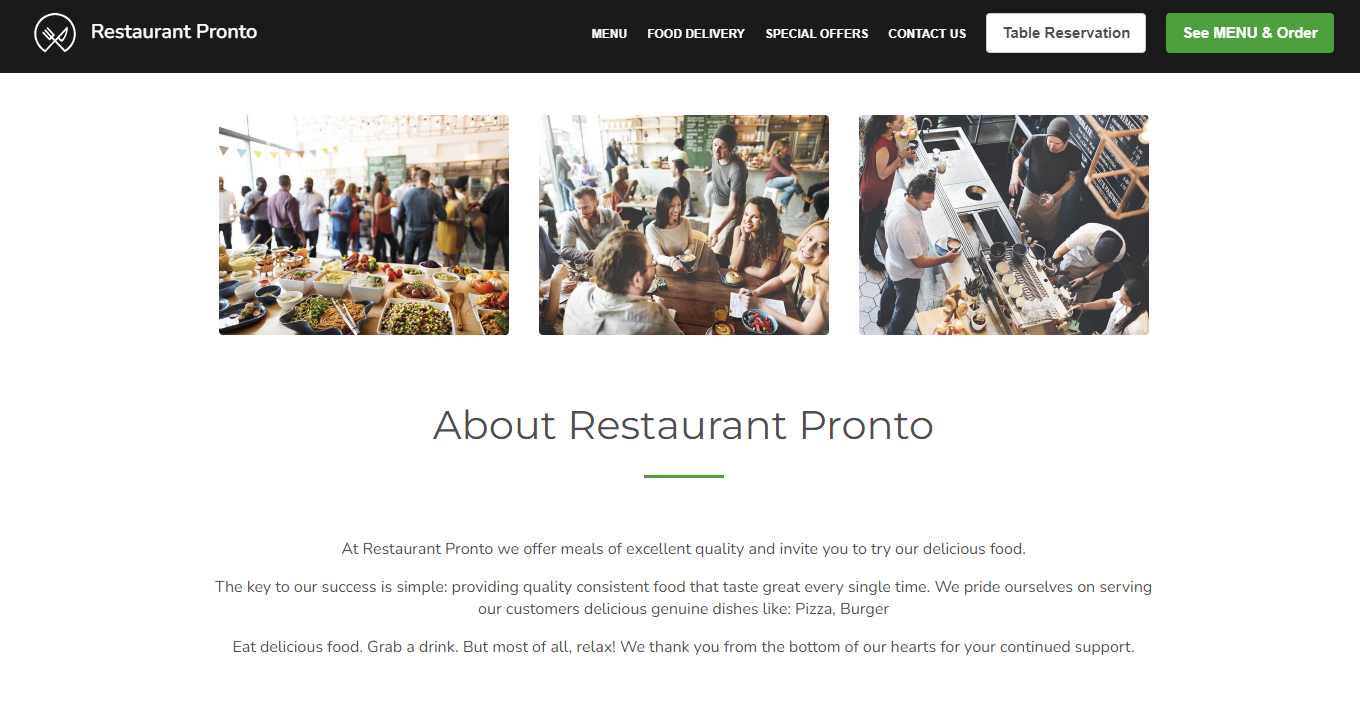- 1.Why do you need a restaurant description?
- 2.Where will you use your restaurant description?
- 3.9 tips on how to write a restaurant description
- Identify your target audience
- Use the tone of voice of your brand
- Include key information
- Don’t forget about keywords
- Focus on what makes your business special
- Be concise
- Have someone proofread the description
- Support your description with visuals
- Keep it updated
- 4.Restaurant description examples
- 5.Final words
As a restaurant owner, you are always dealing with hard tasks, such as writing a comprehensive business plan, hiring productive employees, and creating a profitable menu. This often leaves you with little time to handle the smaller tasks that are equally as important for your business’s success.
For example, how do you write a restaurant description? Don’t worry, we’re here to make it easy for you and save you time with an easy-to-follow guide that will have you creating impressive descriptions in no time.
Why do you need a restaurant description?
Potential customers will form a first impression about your restaurant by browsing your menu, looking at pictures, prices, and menu item descriptions.
But, sometimes, they want to know more about your business before they decide if they want to become a client and they will check your restaurant description.
Having a good restaurant description can help you:
- Connect with potential customers and existing clients: if you write a description where your passion for running a restaurant is obvious, clients will empathize and will be tempted to give your food a try;
- Share your story and values: a person who visits your website for the first time doesn’t know what your restaurant stands for and what you are trying to achieve. A restaurant description gives you the opportunity to boast about your origins, concept, team, and food.
Read more: How to Use Restaurant Storytelling to Craft a Powerful Brand
Where will use your restaurant description?
Once you will have written your compelling restaurant description, you will be able to publish it on:
- Your website, in the About us section: this is where your customers will be looking for it. If you don’t have a website yet or are not satisfied with the one you have, you can generate a sales and SEO-optimized one in less than 10 minutes with GloriaFood;
- Google Business Profile: help customers know more about your business by adding a shorter version of your description on your GBP;
- Social media: add abbreviated forms of your description both in your bio and post descriptions that focus more on your restaurant’s story;
- Press and advertisement materials: when the press writes an article about your website, they will usually ask for a description. You can also include it in more ample advertisement materials such as brochures;
9 tips on how to write a restaurant description
Make a lasting impression by creating a description that resonates with your customers. Below you can find a detailed answer to the question “How do you write a restaurant description?”
1. Identify your target audience
Before you start writing, you need to know who you are addressing. Identifying your target audience is not only helpful for creating a description, but also for branding your restaurant.
Your concept and food won’t be to everyone’s taste, so you must focus on attracting the people who are most likely to make a purchase.
Read more: Restaurant Target Market: How to Identify It and Why It Is Important for Your Business
2. Use the tone of voice of your brand
Branding must be one of the first steps of opening a restaurant because it helps you identify what makes your business unique, your strong points, and helps create a cohesive image on all platforms.
Part of branding is deciding on a tone of voice that you will also use when writing the description.
Read more: 12 Restaurant Branding Ideas to Build a Memorable Presence
3. Include key information
Prior to creating sentences and linking them together, it will be helpful to create a structure with all the information you want to include. Here are the main things you must include:
- Your restaurant’s name
- The type of cuisine you offer, plus some star dishes
- Your restaurant’s location and the type of services you offer, such as online ordering
4. Focus on what makes your business special
Use your restaurant description to showcase what makes you stand out from your competition. Here are a few ideas for what could make your restaurant unique and should be highlighted:
- Unique ingredients, either rare and imported or locally sourced
- Larger portions than the norm
- Better prices than the competition
- A special story about your restaurant’s origin
- An interesting type of food preparation
- Different types of service
- Distinctive decor
5. Don’t forget about keywords
If you are wondering how to write a restaurant description that also helps you rank higher in Google searches, the answer is to include keywords.
Keywords are the specific words or phrases that potential customers use when they are searching for your type of restaurant. If you include them naturally in your content, you increase your chances of appearing in searches.
Use a keyword searching tools to look for keywords such as:
- Your location + your type of cuisine
- Your location + your type of service
- Your location + signature dishes
Read more: SEO for Restaurants Or How to Sell More Food Online
6. Be concise
The average attention span is in continuous decline and people aren’t willing to read two pages worth of description. Stick to three to four paragraphs, no longer than three rows each. Here are some additional tips:
- Start with a bang: use a headline that immediately draws the reader in and lets them know what your business is about. It could even be your Unique selling proposition;
- Use bullet points: if you want to include more information while still making it digestible, use bullet points;
- End with a strong Call to Action: for example, you can invite the reader to discover the food you put so much work in, either in location or at home, through online ordering.
7. Have someone proofread the description
Sometimes, we can’t see our own mistakes. You don’t want to put out a description that is hard to read or has spelling mistakes because it will make a bad impression.
Therefore, gather a team of trusted friends or colleagues and have them look over it and come up with advice on how to improve it. More minds are often better than one, especially if they all want your restaurant to succeed.
Alternatively, you can use a grammar checker free to find and omit mistakes. This specialized tool detects all kinds of errors, including grammar, spelling, punctuation, and structure, and provides you with suggestions to fix them instantly.
If you want to go a step further and improve the tone and readability, consider using an AI humanizer that will make your writing sound more engaging.
You can also use a meta description generator to help with some shorter ideas that you can use for social media.
8. Support your description with visuals
Make your restaurant description more powerful by illustrating it with pictures of your food, your restaurant’s interior, and behind-the-scenes instances.
On your website, you will be able to create a carousel of all of them. On social media, you can also use custom videos created with an AI video generator, alongside the classic images to fit even more information.
9. Keep it updated
Change is to be expected in the food industry. If you want to remain profitable month after month, you must be able to adapt. Whatever change you make to your restaurant should also be reflected in the description, especially if it is a big one such as a different type of cuisine.
Restaurant description examples
Learning how to write a restaurant description can sometimes be easier if you see examples. We’ve created a list for all possible mediums that you can use for inspiration:
Restaurant description example for website
Restaurant Pronto, authentic Neapolitan pizza with high-quality ingredients
Each visit to our New York pizza restaurant will feel like a food vacation in Italy. We only work with trusted ingredients imported from passionate producers that put quality before quantity.
Come and experience our relaxed atmosphere, heated up by the traditional wood-fired stove that lends our pizzas the amazing taste and texture you will be back for.
If you don’t feel like leaving the home, don’t worry, you can now order our delicious pizza online!
Restaurant description example for Google Business Profile
Authentic Neapolitan pizza restaurant in New York where you can take a culinary journey to Italy!
Restaurant description example for social media
The best authentic Neapolitan pizza restaurant in New York with only high-quality ingredients!
Final words
You no longer have to wonder how to write a restaurant description because you have all the knowledge and examples needed for inspiration. It is now time to put it to practice and concoct a description that will attract more customers.


